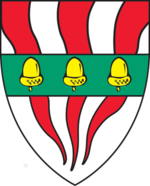
Saybrook College is one of the 14 residential colleges at Yale University.
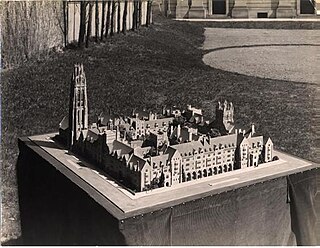
The Memorial Quadrangle is a residential quadrangle at Yale University in New Haven, Connecticut. Commissioned in 1917 to supply much-needed student housing for Yale College, it was Yale's first Collegiate Gothic building and its first project by James Gamble Rogers, who later designed ten other major buildings for the university. The Quadrangle has been occupied by Saybrook College and Branford College, two of the original ten residential colleges at Yale. The collegiate system of Yale University was largely inspired by the Oxbridge model of residential and teaching colleges at the University of Oxford and the University of Cambridge in the UK.

Branford College is one of the 14 residential colleges at Yale University.
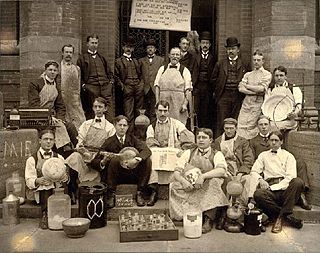
Sheffield Scientific School was founded in 1847 as a school of Yale College in New Haven, Connecticut, for instruction in science and engineering. Originally named the Yale Scientific School, it was renamed in 1861 in honor of Joseph E. Sheffield, a railroad executive. The school was incorporated in 1871. The Sheffield Scientific School helped establish the model for the transition of U.S. higher education from a classical model to one which incorporated both the sciences and the liberal arts. Following World War I, however, its curriculum gradually became completely integrated with Yale College. "The Sheff" ceased to function as a separate entity in 1956.

Berkeley College is a residential college at Yale University, opened in 1934. The eighth of Yale's 14 residential colleges, it was named in honor of Bishop George Berkeley (1685–1753), dean of Derry and later bishop of Cloyne, in recognition of the assistance in land and books that he gave to Yale in the 18th century. Built on the site of a group of buildings known from the 1890s until 1933 as the Berkeley Oval, the college was renovated in 1998. It is distinct for having two courtyards connected by an underground tunnel.
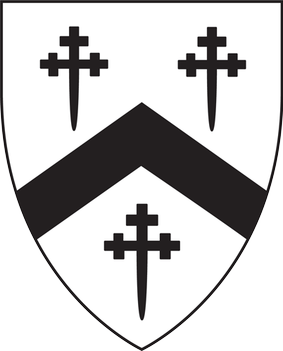
Davenport College is one of the fourteen residential colleges of Yale University. Its buildings were completed in 1933 mainly in the Georgian style but with a gothic façade along York Street. The college was named for John Davenport, who founded Yale's home city of New Haven, Connecticut. An extensive renovation of the college's buildings occurred during the 2004–2005 academic year as part of Yale's comprehensive building renovation project. Davenport College has an unofficial rivalry with adjoining Pierson College.
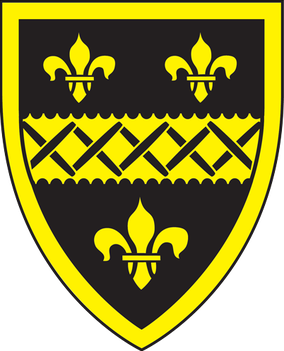
Ezra Stiles College is one of the fourteen residential colleges at Yale University, built in 1961 and designed by Eero Saarinen. It is often simply called "Stiles", despite an early-1990s crusade by then-master Traugott Lawler to preserve the use of the full name in everyday speech. The college is named after Ezra Stiles, the seventh President of Yale. Architecturally, it is known for its lack of right angles between walls in the living areas. It sits next to Morse College.

Morse College is one of the fourteen residential colleges at Yale University, built in 1961 and designed by Eero Saarinen. It is adjacent to Ezra Stiles College and the two colleges share many facilities. The current Head of College is Catherine Panter-Brick. The Associate Head of College is Mark Eggerman. Blake Trimble is the Dean of Morse College.
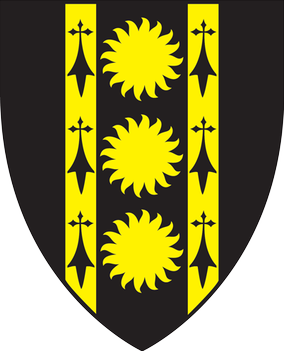
Pierson College is a residential college at Yale University in New Haven, Connecticut. Opened in 1933, it is named for Abraham Pierson, a founder and the first rector of the Collegiate School, the college later known as Yale. With just under 500 undergraduate members, Pierson is the largest of Yale's residential colleges by number of students.

Timothy Dwight College, commonly abbreviated and referred to as "TD", is a residential college at Yale University named after two presidents of Yale, Timothy Dwight IV and his grandson, Timothy Dwight V. The college was designed in 1935 by James Gamble Rogers in the Federal-style architecture popular during the elder Timothy Dwight's presidency and was most recently renovated in 2002. In 2021, TD won its Yale-leading 14th Tyng Cup, the championship prize for Yale's year-long intramural athletic competition among the fourteen residential colleges. The current Head of College is Mary Ting Yi Lui and the current Dean is Sarah Mahurin. Both are the first women to hold their respective positions.

Trumbull College is one of fourteen undergraduate residential colleges of Yale University in New Haven, Connecticut, United States. The college is named for Jonathan Trumbull, governor of Connecticut from 1769 to 1784 and advisor and friend to General George Washington. A Harvard College graduate, Trumbull was the only colonial governor to support the American Revolution.

Jonathan Edwards College is a residential college at Yale University. It is named for theologian and minister Jonathan Edwards, a 1720 graduate of Yale College. JE's residential quadrangle was the first to be completed in Yale's residential college system, and was opened to undergraduates in 1933.

The Old Campus is the oldest area of the Yale University campus in New Haven, Connecticut. It is the principal residence of Yale College freshmen and also contains offices for the academic departments of Classics, English, History, Comparative Literature, and Philosophy. Fourteen buildings—including eight dormitories and two chapels—surround a 4-acre (1.6 ha) courtyard with a main entrance from the New Haven Green known as Phelps Gate.
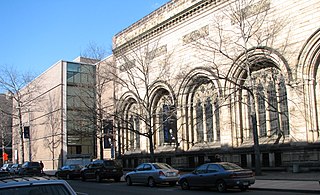
The Yale University Art Gallery (YUAG) is the oldest university art museum in the Western Hemisphere. It houses a major encyclopedic collection of art in several interconnected buildings on the campus of Yale University in New Haven, Connecticut. Although it embraces all cultures and periods, the gallery emphasizes early Italian Renaissance painting, African sculpture, and modern art.
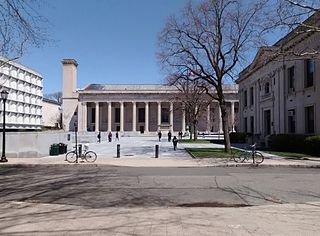
Hewitt University Quadrangle, commonly known as Beinecke Plaza, is a plaza at the center of the Yale University campus in New Haven, Connecticut. It is the home of the university's administration, main auditorium, and dining facilities. The quadrangle was created with the construction of the university's Bicentennial Buildings and Woodbridge Hall in 1901. Until 1917, it was known as University Court. The completion of the Beinecke Library created subterranean library facilities beneath the courtyard, establishing the present appearance of the paved plaza and sunken courtyard.

Connecticut Hall is a Georgian building on the Old Campus of Yale University. Completed in 1752, it was originally a student dormitory, a function it retained for 200 years. Part of the first floor became home to the Yale College Dean's Office after 1905, and the full building was converted to departmental offices in the mid-twentieth century. It is currently used by the Department of Philosophy, and its third story contains a room for meetings of the Yale Faculty of Arts & Sciences, the academic faculty of Yale College and the Graduate School.

Eggers & Higgins was a New York architectural firm partnered by Otto Reinhold Eggers and Daniel Paul Higgins. The architects were responsible for the construction phase of the Thomas Jefferson Memorial beginning in 1939, two years after the death of its original architect, John Russell Pope, despite protests that their appointment had been undemocratic and therefore "un-Jeffersonian". Critics argued a competition should have been held to choose Pope's successor. In 1941, they also completed construction of Pope's other famous design, the West Building of the National Gallery of Art, also in Washington, D.C.
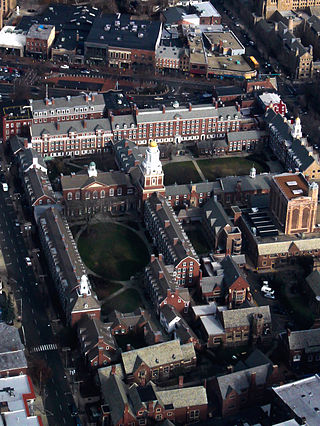
Yale University has a system of fourteen residential colleges with which all Yale undergraduate students and many faculty are affiliated. Inaugurated in 1933, the college system is considered the defining feature of undergraduate life at Yale College, and the residential colleges serve as the residence halls and social hubs for most undergraduates. Construction and programming for eight of the original ten colleges were funded by educational philanthropist Edward S. Harkness. Yale was, along with Harvard, one of the first universities in the United States to establish a residential college system.

Durfee Hall is a freshman residential dormitory on the Old Campus of Yale University. Built in 1871, it is the second oldest residential building at Yale, only after Farnam Hall. Currently, the building is used to house first-year students of Morse College, who stay there for the duration of their freshman year before moving into Morse College proper.

Science Hill is an area of the Yale University campus primarily devoted to physical and biological sciences. It is located in the Prospect Hill neighborhood of New Haven, Connecticut.
